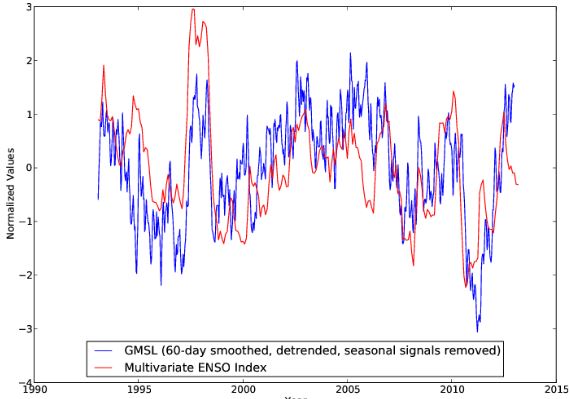The world is going underwater?…Really?
By
(Translated/edited, subheadings by P. Gosselin)
“Der Spiegel” has an in-house columnist on climate issues: Stefan Rahmstorf from PIK Potsdam. His latest prank: “Why the sea level is rising faster and faster“. He writes in the introduction, citing data:
The rate of rise has doubled during this period, from 2.1 to 4.8 mm per year.”
We want to check this and find something: the European data from “Copernicus”. They cover the period from 1993 to March 2020, so they are very recent. Now we search for the trend increase claimed by Rahmstorf and calculate 5-year trends of the global measured values up to the year plotted on the abscissa:

Fact: No long term trend change
Indeed we find the trend increase: if the 5-year trends were quite accurate at 3 mm/year until 2003, they dropped until 2011, after which they increased to the value Rahmstorf mentioned until 2015, but then dropped again to the just a little above the 3mm/year they already had at the beginning.
Has the long-term trend changed? No, From 1993 to now it is quite exactly 3 mm/year.
Rahmstorf shady use of statistics
Does internal variability play into it, which influences the (in terms of climate) still rather short data set of 1993-2019 (complete years) in such a way that one can interpret all sorts of things into it, if one wants to?
We find a hint where Rahmstorf linked to the data, but we have to look into the past of the website of the University of Colorado:

No serious oceanographer
In 2013 (after a strong La Nina event in 2012) it was shown there how the sea level rise depends on La Nina and El Nino (ENSO for short).
After the La Nina in 2012, there was an El Nino in 2016, so this explains the peak in the top image. What Rahmstorf calls a “consequence of fossil energy use” (namely the trend increase of sea level rise) in a bold subheading of his “Spiegel” article is in reality the consequence of natural ENSO variability? We can’t accept this from a serious oceanographer (his job title).
New peer reviewed paper contradicts Rahmtorf
We therefore look into peer-reviewed science and come across a very recent paper (Iz & Shum 2020) in the Journal of Geodetic Science. The authors examine much more meticulously than we have been able to do with the data set of satellite-based observations of sea level and find plenty of natural forcing variables that belie some acceleration in the short data set.
The authors end by advising that assessments of future trends should be “undertaken with extreme caution.”
Rahmstorf does not do this when he later concludes, “Houston, we have a problem.” What follows from Rahmstorf is the ever familiar narrative: tipping points of Greenland ice, etc. etc.. Again he ends with the well-known:
The next two decades will determine how many island nations will sink and how many coastal cities will be flooded.”
You can write something like that, but it has nothing in the least to do with science.
Sloppy journalism by Spiegel? “Embarrassing”
The “Spiegel” should correctly mark the article of Rahmstorf as “a citizen’s opinion” because it is nothing more. He neither reports the state of science nor shows the uncertainties of his own conclusions.
Embarrassing for an oceanographer.





[…] Reposted from the NoTricksZone […]
Determining changes in SLR by comparing 5-year trends is absurd and ridiculous, because the error bars on such trends — which you didn’t calculate — are huge, so the error bars on the comparisons will be huge. You get nothing useful.
When I fit a quadratic curve to the SL data since 1993 — from Aviso, which I’ve done, and presumably from NASA and Copernicus — I get a current SLR of 4.4 mm/yr, and a current acceleration of 0.068 mm/yr2. (Yes, these have error bars; calculate them if you want to know them.)
Stefan Rahmstorf is correct. Of course.
Wait, I did calculate the uncertainty on the present acceleration. It’s 0.006 mm/yr2, sans autocorrelation.
[…] Notrickszone übernahm und trug es auf englisch in die weite Welt hinaus. Schließlich landete der Artikel auch im weltweit größten Klimablog WUWT: […]
[…] Spiegel Article By Stefan Rahmstorf Has “Nothing In The Least To Do With Science”…… […]